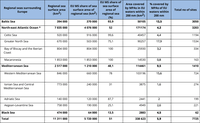
The factors considered are intercontinental transport (‘bckd’, pink box), European emission strategies (‘emissions’, blue), and climate change (‘climate’, orange). The net (‘All’, white) modelled ozone change is expressed in SOMO35. Graph presents the modelled ozone change in 2050 compared to the present day for a reference (left) and climate mitigation (right) scenarios

The table shows the areal extent of Europe's seas and selected characteristics of EU marine protected areas (MPAs), namely area coverage, percentage of coverage and total number of sites.
Data excludes the Icelandic Sea, Norwegian Sea and the Barents Sea

The table shows the percentage cover of MPAs and distance to 10% target for each regional and sub regional sea and by distance zone from the coastline modified from the report: Spatial analysis of Marine Protected Area Networks in Europe´s seas. EEA Technical report, no 17/2015

Map shows the patterns of fragmentation in the 29 countries investigated based on a grid of cells size of 1 km2

This Sankey diagram shows the composition of the primary energy entering the energy system of the EU-28 in 2013, and where this primary energy was used, either as losses or as consumption by specific sectors of the economy.
The units are million tonnes of oil equivalent (Mtoe).

The map show the proportion of landscape units per connectivity range reported by country for the year 2006.
The trend (medium/low increase/decrease or stable) in the proportion of units in a high connectivity range (above 50%) is given for the period 2000-2006 per country.
Species dispersing is 1 km.

The map shows the spread of artificial and/or agricultural surfaces into previously ‘core natural/semi-natural’ landscapes for the period 2000-2006. Reporting is made per province (NUTS 2/3), both in terms of absolute area (ha) and proportionally to the ‘core natural’ pattern cover in 2000. For example, one province in the West of Spain had its ‘core natural’ pattern reduced by 1.5% to 3% due to fragmentation by agricultural and/or artificial lands, from a cumulative area of more than 10 000 ha.

Observed air quality concentration maps for 2013 for components O3, PM10, NO2, PM2.5 and BaP.

The map shows the condition of agro ecosystems map. Based on pan-European High Nature Value farmland map using as mask the agricultural categories of Corine land cover map of 2006.

The map shows the different marine protected areas (MPA) designated under the Regional Sea Conventions

The map shows the facts on the EU Marine Protected Area Networks

The maps shows the regional seas surrounding Europe and the sustainability challenges they face